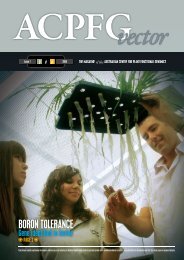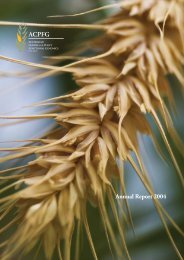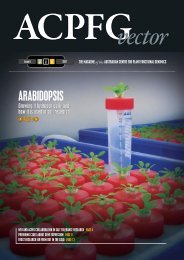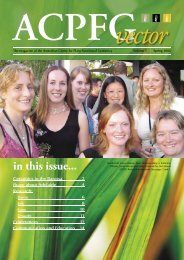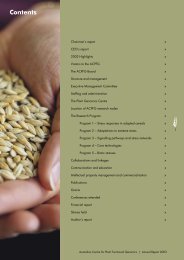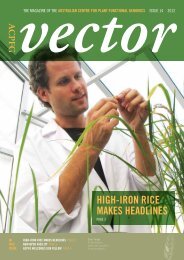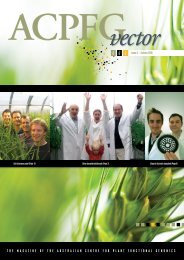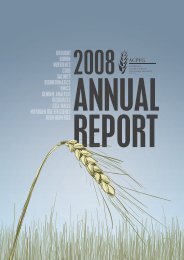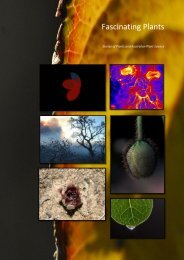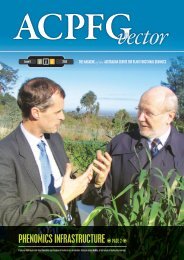Issue 4 2006 - acpfg
Issue 4 2006 - acpfg
Issue 4 2006 - acpfg
Create successful ePaper yourself
Turn your PDF publications into a flip-book with our unique Google optimized e-Paper software.
ACPFG VECTOR ISSUE 4 – WINTER <strong>2006</strong>Dr Patterson examining whole plants, a view he doesn’t usually getTracking proteinsfor boron toleranceBy Dr John PattersonACPFG scientists are using newtechniques to identify hundredsof proteins in a single experiment,helping to establish howplants respond to boron stress.As well as looking at plantgenes, ACPFG scientists researchproteins and metabolites, whichare products of gene expression.Genes encode proteins andproteins catalyse the formationof metabolites. Every aspect ofa plant’s development dependson the coordinated expression ofgenes, proteins and metabolites– as do stress responses.At the ACPFG proteomics nodeat the University of Melbourne,we use instruments called massThe Melbourne Proteomics groupspectrometers to identify andsequence proteins. This involvesisolating the protein, then choppingit up into shorter peptidesusing enzymes that recognizeparticular amino acids. The massspectrometercan then find theamino acid sequence of individualpeptides. Using this approach, wecan follow changes in the abundanceof one or a few proteins ina single experiment.What we haven’t been ableto do is compare lots of proteinsat once. This has made it impossibleto collect protein abundancemeasurements that can be linkedto both gene and metaboliteexpression data experiments.Being able to dothis would allowus to look at theplant biology atevery step of thegene to proteinto metabolitepathway.In the lastfew years, multidimensionalprotein identificationtechnologyhas beendeveloped, andgiven the nickname MuDPIT.This allows scientists to identifyhundreds of proteins in a singleexperiment. MuDPIT still usesmass spectrometry, but the proteinsare chopped up into a morecomplex mixture of peptides,and are then separated in severalmore ways. A lot of computingpower is used to identify theproteins using this technology,and our resident software guru,Andrew Cassin, has developed anumber of in-house software toolsto make this work.MuDPIT has made a bigdifference in proteomics, butit has remained difficult tocompare protein abundances indifferent samples. Recently, wehave combined MuDPIT with areagent called iTraq, which allowsus to measure and compare theamounts of proteins in up to foursamples at the same time.This new technology is helpingACPFG researchers betterunderstand how plants respondto stresses at the gene, protein andmetabolite levels. So every stepof the gene-protein-metabolitepathway is now being followed.We have recently used thisapproach to compare plantsthat are tolerant or intolerantto the element boron. Boronis essential for healthy plantgrowth and reproduction, buttoo much causes problems.We have identified interestingcandidate proteins that arepresent in different amounts indifferent plants. The role theseproteins may play in boron toleranceis now being examined– stay tuned!Dr John Patterson joined theteam at the Melbourne proteomicsnode of the ACPFG in 2003. He isa Biochemist using proteomics tounderstand how cereals respond toboron and drought stress.Dr Patterson completed hisundergraduate and postgraduatestudies at the University ofMelbourne. During his PhD in thebiochemistry department, he lookedat pathways of cell wall formationin bacteria that cause tuberculosis,leprosy and Johne’s disease.By Nikki ApplebyA bioinformatics workshop at theACPFG in Queensland demonstratedthe potential of computersin biological sciences.Functional genomics involveshandling a lot of data. In lookingat how stresses affect cerealyield, for example, scientists willgather thousands of points of datadescribing links between a plant’sgenetic blueprint, its environmentand its phenotype.The job of analysing suchlarge amounts of data is donewith computers, by turning thebiological data into a problem,solving the problem and thenconverting the results back intobiologically relevant knowledge.This is bioinformatics.Recently a five-day bioinformaticsworkshop was heldat the ACPFG’s University ofQueensland (UQ) node, led byProfessor Vladimir Brusic. Twentypeople attended the workshop,which aimed to show how toapply bioinformatics techniques toindividuals’ research problems.On the first day the participantschose a research problem in theirarea that could be solved usingbioinformatics, and then workedon their problem for the week.Participants’ research problemscovered humans, animals andplants, with topics as diverseas aluminium tolerance, breastcancer and schizophrenia.One participant wanted tolearn more about proteins in theThe bioinformatics workshops in actionbrain that appear to be involvedin schizophrenia. He discoveredbioinformatics could help byexamining published metabolicpathways involving the proteins.He also found that there wasvaluable data in existing proteinproteininteraction databases.A participant from the ACPFGwanted to find information abouta gene called ALMT1, which isinvolved in ‘mopping up’ aluminiumions in wheat. Usingbioinformatics algorithms he wasable to compare this gene’s DNAPhD student Nikki Appleby, at the ACPFG’s University of Queenslandnode, has won a prestigious award for women in technology industries.The bioinformatics student beat 150 applicants in informationtechnology, science and engineering, to win the Women in Technology(WIT) Postgraduate Research Award.Nikki said that careers in technology are now more appealing towomen than when she began studying.“The hours are more flexible than other jobs so you can make itwork for you, whether you intend to be a career specialist or embracemotherhood. There is a lot of scope to change subject areas like I have,so you never get bored!”The WIT awards aim to attract and retain women in technology,allowing winners to accelerate their careers with professional developmentand industry recognition.Navigating a maze of data withbioinformaticssequence with known genomesacross many species. He foundsimilar DNA sequences in severalplant genomes, suggesting thesequence has been conserved.Conserved sequences are oftenbiologically important as theyhave remained largely unchangedas species have evolved. Itappears this DNA sequence hasmaintained its aluminium tolerancefunction across species.Using bioinformatics, scientistscan now study biologicalproblems in silico, which makesaccessing and understanding largeamounts of data easier than everbefore. Professor Brusic emphasisedthat to use bioinformaticseffectively, it is important for scientiststo work across disciplineswith specialist co-workers. Theworkshop allowed participants totake their first steps in what mayseem a bewildering maze of dataand tools, but what is in fact afield of opportunity.Nikki Appleby is a PhDstudent with the ACPFG at theUniversity of Queensland. She isintegrating data from multiplesources to help discover novel genetargets for abiotic stress tolerancein unsequenced genomes.Nikki with the other award winners and Queensland Information Technology Policy Minister, Chris Cummins MP



